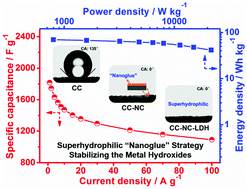当前位置:
X-MOL 学术
›
Energy Environ. Sci.
›
论文详情
Our official English website, www.x-mol.net, welcomes your
feedback! (Note: you will need to create a separate account there.)
A superhydrophilic “nanoglue” for stabilizing metal hydroxides onto carbon materials for high-energy and ultralong-life asymmetric supercapacitors
Energy & Environmental Science ( IF 32.4 ) Pub Date : 2017-05-31 00:00:00 , DOI: 10.1039/c7ee01040k Shaofeng Li 1, 2, 3, 4, 5 , Chang Yu 1, 2, 3, 4, 5 , Juan Yang 1, 2, 3, 4, 5 , Changtai Zhao 1, 2, 3, 4, 5 , Mengdi Zhang 1, 2, 3, 4, 5 , Huawei Huang 1, 2, 3, 4, 5 , Zhibin Liu 1, 2, 3, 4, 5 , Wei Guo 1, 2, 3, 4, 5 , Jieshan Qiu 1, 2, 3, 4, 5
Energy & Environmental Science ( IF 32.4 ) Pub Date : 2017-05-31 00:00:00 , DOI: 10.1039/c7ee01040k Shaofeng Li 1, 2, 3, 4, 5 , Chang Yu 1, 2, 3, 4, 5 , Juan Yang 1, 2, 3, 4, 5 , Changtai Zhao 1, 2, 3, 4, 5 , Mengdi Zhang 1, 2, 3, 4, 5 , Huawei Huang 1, 2, 3, 4, 5 , Zhibin Liu 1, 2, 3, 4, 5 , Wei Guo 1, 2, 3, 4, 5 , Jieshan Qiu 1, 2, 3, 4, 5
Affiliation

|
Coupling electroactive species with carbon supports to fabricate hybrid electrodes holds promise for high-performance supercapacitors. Nevertheless, the poor compatibility and weak bonding between carbon substrates and electroactive species remain a bottleneck to be tackled. Herein, we present a superhydrophilic “nanoglue” strategy for stabilizing NiCo-layered double hydroxide (NiCo-LDH) nanosheets on inert carbon cloth (CC) by employing a nitrogen-doped (N-doped) carbon layer as the structure/interface coupling bridge to make hybrids (denoted as CC–NC-LDH) for supercapacitors. Such a “nanoglue” on a CC substrate results in the formation of a superhydrophilic surface/interface, which is favorable for the robust and uniform growth of NiCo-LDH on the CC, and helps effectively tune the electronic structural states and results in a strong coupling interaction between the CC and NiCo-LDH nanosheets. Benefiting from these integrated merits, asymmetric supercapacitors fabricated with the CC–NC-LDH hybrids as the positive electrode and typical activated carbon as the negative electrode deliver a high energy density of 69.7 W h kg−1 at a power density of 0.8 kW kg−1, with an ultra-low average capacitance fade rate of ∼0.00065% per cycle within 20 000 cycles at a current density of 10 A g−1. This superhydrophilic “nanoglue” strategy can also be extended to assemble other kinds of active species on different inert substrates, and holds the potential for creating efficient and robust electrode materials for energy-related devices.
000 cycles at a current density of 10 A g−1. This superhydrophilic “nanoglue” strategy can also be extended to assemble other kinds of active species on different inert substrates, and holds the potential for creating efficient and robust electrode materials for energy-related devices.
中文翻译:

用于将金属氢氧化物稳定在碳材料上的超亲水“纳米胶”,用于高能和超长寿命不对称超级电容器
将电活性物质与碳载体偶联以制造混合电极,为高性能超级电容器提供了希望。然而,碳基材与电活性物质之间的差的相容性和弱结合仍然是要解决的瓶颈。在这里,我们提出了一种超亲水性的“纳米胶”策略,通过使用氮掺杂(N掺杂)碳层作为结构/界面耦合桥来稳定惰性碳布(CC)上的NiCo层状双氢氧化物(NiCo-LDH)纳米片。制造用于超级电容器的混合动力车(表示为CC–NC-LDH)。CC基材上的这种“纳米胶”导致形成超亲水性的表面/界面,这有利于NiCo-LDH在CC上的牢固且均匀的生长,并有助于有效地调节电子结构态,并导致CC和NiCo-LDH纳米片之间的强耦合相互作用。受益于这些综合优点,使用CC–NC-LDH混合电池作为正极,典型的活性炭作为负极制造的不对称超级电容器可提供69.7 W h kg的高能量密度-1在功率密度为0.8 kW kg -1的情况下, 在10 A g -1的电流密度下,在20000次循环中,每循环的平均电容衰减率超低至0.00065%。这种超亲水性的“纳米胶”策略还可以扩展为在不同的惰性基质上组装其他种类的活性物质,并具有为能源相关设备制造高效而坚固的电极材料的潜力。
在10 A g -1的电流密度下,在20000次循环中,每循环的平均电容衰减率超低至0.00065%。这种超亲水性的“纳米胶”策略还可以扩展为在不同的惰性基质上组装其他种类的活性物质,并具有为能源相关设备制造高效而坚固的电极材料的潜力。
更新日期:2017-09-13
 000 cycles at a current density of 10 A g−1. This superhydrophilic “nanoglue” strategy can also be extended to assemble other kinds of active species on different inert substrates, and holds the potential for creating efficient and robust electrode materials for energy-related devices.
000 cycles at a current density of 10 A g−1. This superhydrophilic “nanoglue” strategy can also be extended to assemble other kinds of active species on different inert substrates, and holds the potential for creating efficient and robust electrode materials for energy-related devices.
中文翻译:

用于将金属氢氧化物稳定在碳材料上的超亲水“纳米胶”,用于高能和超长寿命不对称超级电容器
将电活性物质与碳载体偶联以制造混合电极,为高性能超级电容器提供了希望。然而,碳基材与电活性物质之间的差的相容性和弱结合仍然是要解决的瓶颈。在这里,我们提出了一种超亲水性的“纳米胶”策略,通过使用氮掺杂(N掺杂)碳层作为结构/界面耦合桥来稳定惰性碳布(CC)上的NiCo层状双氢氧化物(NiCo-LDH)纳米片。制造用于超级电容器的混合动力车(表示为CC–NC-LDH)。CC基材上的这种“纳米胶”导致形成超亲水性的表面/界面,这有利于NiCo-LDH在CC上的牢固且均匀的生长,并有助于有效地调节电子结构态,并导致CC和NiCo-LDH纳米片之间的强耦合相互作用。受益于这些综合优点,使用CC–NC-LDH混合电池作为正极,典型的活性炭作为负极制造的不对称超级电容器可提供69.7 W h kg的高能量密度-1在功率密度为0.8 kW kg -1的情况下,
 在10 A g -1的电流密度下,在20000次循环中,每循环的平均电容衰减率超低至0.00065%。这种超亲水性的“纳米胶”策略还可以扩展为在不同的惰性基质上组装其他种类的活性物质,并具有为能源相关设备制造高效而坚固的电极材料的潜力。
在10 A g -1的电流密度下,在20000次循环中,每循环的平均电容衰减率超低至0.00065%。这种超亲水性的“纳米胶”策略还可以扩展为在不同的惰性基质上组装其他种类的活性物质,并具有为能源相关设备制造高效而坚固的电极材料的潜力。









































 京公网安备 11010802027423号
京公网安备 11010802027423号